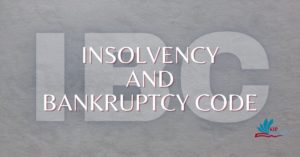The Parliament in the year 2016 introduced the much awaited reformed and an exhaustive law on matters specially limited to Insolvency and Bankruptcy. The Act was designed in order to give a more of a procedural aspect to the whole concept and hence it is in form of a code and not provisions. The preamble of the Code provides for giving step wise solution to Insolvency and Bankruptcy of Corporate , Individuals and Partnership Firm. The Code Consolidates and amends all such Acts and brings it under one uniform roof thus providing a complete guidance and solution to the Corporate Insolvency Resolution Process or the CIRP as it’s commonly known.

Insolvency and Bankruptcy Code IBC
The main purpose of the introducing this Code was to ensure the continuation and running of the affairs of the Corporate Debtor or the Individual or Partnership Firm as the case may be thus giving them ample opportunities to revive , restructure and rebuilt their business. The legislative intent makes it amply clear that so long as the business continues as a going concern , all the stakeholders which also includes the Government and the People of India , would largely benefit and the economic progress shall never be stalled.
India has witnessed a considerable increase in the number of cases filed before the Humble NCLT which is the judiciary body for admitting , hearing and deciding cases mainly related to Insolvency and Bankruptcy. There have been several landmark judgments which now have become the law when touching upon the important aspect of the Code.
The Code with its Regulations and Amendments in the same included Personal Guarantors to the Corporate Debtor and brought them under the ambit of the Code. The recent decision in the Lalit Kumar v Union of India , the Apex Court held that as per the amendments in Act 8 of 2018 and Act 26 of 2018 , Personal Debtors to the Corporate Debtors were included under the scope of the said Code and the Secured Creditor can move against the Personal Guarantors for the recovery of their dues and initiating CIRP or Liquidation in case of any default by the Corporate Debtor. The Supreme Court further stated the provisions of the Indian Contract Act with regards to Guarantee and reiterated Section 128 that the liability of the Guarantor is co-extensive with that of the Principal Debtor unless otherwise provided under the contract.
In another landmark case of Swiss Ribbons v Union Of India , the Apex Court in giving a detailed and a reasoned order touched upon various sections of the Code which in the eyes of the petitioner was Unconstitutional , Arbitrary and and given unfettered powers to the Committee of Creditors ( Coc ).The Supreme Court held that the priority of Secured Creditors over the Operational Creditors is not violative to Article 14 as the main intent of the legislation is to ensure that the secured creditors such as the Banks and Financial Institutions get their share of dues as they are instrumental in providing funds to the People of India which makes their commitment and contribution to the overall progress of the economy more significant to that of the operational creditors. Also ,it firmly held that once the CIRP Process has been approved and initiated , it is not within the means of the Creditors to stall the said process thus upholding the validity of Section 12A.
In the case of Essar Steel , set excellent precedents that it is the duty of the Judiciary to look into the Resolution Process beyond the letters of Law and in true spirits such that it doesn’t defeat the purpose of the Code. It held the validity of Section 29A which provides for the Disqualification of the Resolution Professional and seeks an impartial and non biased method of conducting the CIR process.
The Code provides for a constitution of a Regulatory Board to be called as Insolvency and Bankruptcy Board of India or IBBI for short which provides for a uniform method of introduction of new Resolution Professionals and Information Utility and cast upon them serious responsibities to ensure that the process is carried out as per the procedure laid down under the code and that all the information in the Information Utility is registered and proper timely access is given to anyone who should be in possession of such information.
With the introduction of the Code , even the Banks and Financial Institutions are considering to invoke the process and procedure as envisaged indoor to get the true value of assets on which they have created Security Interest without resorting to stringent and lengthy process under the SARFAESI Act,2002.